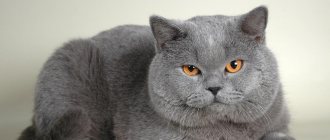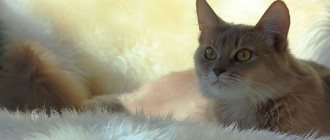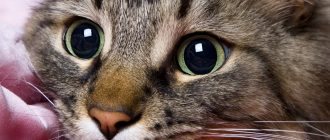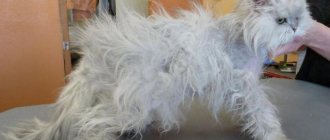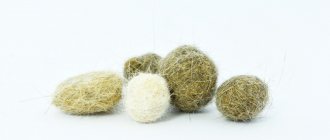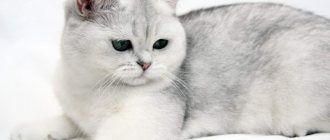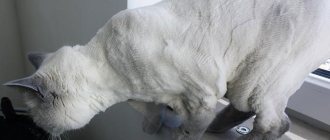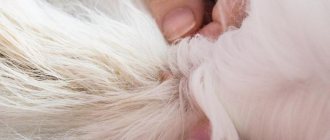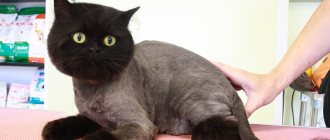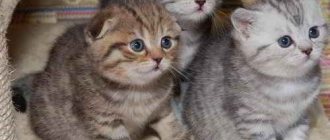What to do if your British cat sheds a lot
In order to shorten the shedding period of a British cat, veterinary experts recommend using the following methods:
- Switch your pet to high-quality food and ensure your pet receives the necessary vitamins and microelements.
- In the autumn, reduce daylight hours for your pet - there is no need to leave your British cat in a lighted room in the evenings.
- Do not let the animal sleep on radiators or in other warm places. Be sure to ventilate the room at night.
- The air in the room where the cat is kept should not be dry.
In any case, such measures will help the molt proceed without complications and provide the animal with the greatest comfort.
Important! Any deviation from the norm during shedding or the formation of bald patches as a result of excessive hair shedding is a reason for an urgent visit to a specialized veterinary clinic.
Grooming
To keep your domestic cat's coat beautiful and healthy, you need to brush it regularly, this will stimulate hair growth.
It is necessary to provide adequate nutrition: food should be varied, rich in vitamins and microelements, spicy, fried and fatty foods should be excluded. To avoid the occurrence of skin diseases, vaccinations must be done on time. If the owner notices that the fur is growing too much, the most correct action would be to contact a veterinarian. The doctor will examine the animal and prescribe treatment.
What to pay attention to
In addition, in British cats, shedding is caused by internal disturbances in the functioning of the body. At the slightest suspicion, you should also go to a veterinary clinic in order to, if possible, prevent or cure all diseases in the early stages.
If your British cat is shedding, don’t panic and immediately run to the doctor; the problem can be easily solved at home. Your cat’s healthy coat is the key to its impeccable health and the owner’s endless love for his pet.
Let's talk about vitamins
Does your cat shed a lot? What to do if you don't know? You need to contact a veterinary clinic. Doctors will conduct an examination there. If they do not find any serious diseases, then a special vitamin complex will be recommended in this situation.
Many animals that lack B vitamins begin to lose a lot of hair. As a rule, B2 and B5 are responsible for the thickness of the hair coat in cats. If the latter is lacking, then in addition to intense shedding, dermatitis may occur. The pet is often in a nervous state. If there is a deficiency of B2, the animal may become completely bald in the area of the back, chest and eyes. His cornea becomes very cloudy and small cracks appear in the corners of his mouth. His body becomes very weak.
Vitamins for cats against hair loss are sold in tablets. They may contain not only elements of group B, but also iodine, biotin, seaweed extract, and sulfur.
It is advisable not to limit yourself to vitamins alone; it is better to purchase complexes that also include minerals.
Why and how cats shed
Subsequently, molting will become regular. For cats, this is a natural process of preparing for the change of season. Ideally, a cat sheds twice a year:
- before the cold weather begins. Reducing daylight hours and a significant decrease in temperatures include protective mechanisms that involve a change in wardrobe. Cats are rapidly growing a new coat that can protect them from frost. For example, the British grow a powerful, dense undercoat, which is much thicker than the summer one;
- before the onset of heat. Rising temperatures make it necessary to prepare for the summer heat. “Winter” fur, having served its purpose, is no longer needed. Therefore, a lightweight version is growing.
Cats that have free range react most strongly to the change of seasons. Their bodies are exposed to natural weather conditions and are sensitive to the changing seasons.
Cats living in an apartment without walking, despite the lack of seasonality in the home climate, also shed. Only the time of this process is not strictly tied to the environment. Depending on the breed, cats shed 1-2 times a year.
It should be borne in mind that in mature, uncastrated cats, shedding can begin at any time as a reaction to certain changes in physiology. This is how the body will react to hormonal changes during estrus or after kittens are weaned from mother's milk. This is not a reason to panic, you just need to provide your cat with improved nutrition and vitamins.
Your pet is shedding - it doesn't hurt to be careful
In addition to the reasons already mentioned that provoke molting in a cat, more serious events may also occur.
However, in most cases there is no reason for this, since in winter a British cat receives less vitamins, warmth and care. This is what causes the British cat to begin to actively shed.
In addition, you can name several more reasons when a pet sheds:
- stressful situations: in most cases this is associated with moving, undergoing operations or long-term illnesses;
- childbirth: in addition to the fact that the pregnancy process itself takes away strength, babies take almost all the nutrients from the mother, as a result of which she begins to shed;
- poor nutrition: cats react very sensitively to the slightest changes in their tiny bodies, so a healthy diet is very important;
- allergic reactions: most often occurs due to the British intolerance to certain types of dry food;
- hormonal surges: especially noticeable in breastfeeding women after childbirth;
- the presence of fungi and diseases.
Sudden
The cause of sudden shedding of a British cat is most often diseases caused by a sudden change in diet, deterioration of living conditions and other factors.
A British cat's hair sheds a lot in the initial stages of the development of skin diseases. Most often this manifests itself at the local level and is expressed by focal lesions.
Sudden molting is always a consequence of some negative phenomena of a physical or psychological nature. As soon as the irritating factor is eliminated, the shedding of fur will immediately stop. Otherwise, the process moves to the next phase.
Seasonal molting of the British: how to make the process invisible
For each breed, the molting period may differ slightly both in the time of its appearance and in the characteristics of its passage. The British Fold cat sheds twice a year - in spring and autumn.
. On average, the process takes place over one month, but may be delayed due to temperature changes.
If you are tired of constantly cleaning your apartment, removing hair from furniture and other similar problems, you should familiarize yourself with the basic rules of care during such a difficult period. These include the following:
- maintaining stability in the microclimate of the room, relatively equal temperature indicators;
- a caring and reverent attitude towards the animal, which will protect both you and your pet from unnecessary stressful situations;
- regular bathing using coat care shampoos;
- carefully comb the fur every day with a massage comb, perhaps using a brush with metal teeth;
- correct and enriched with vitamins and microelements will help your pet when shedding.
The reasons for shedding in a British cat can be varied, including non-compliance with the above mentioned rules.
How to reduce the amount of hair?
It happens that a cat sheds a lot. What to do in this case, how to reduce the amount of hair falling out? The first assistant to the owner of a shedding cat with a thick undercoat is the Furminator. To prevent mats from forming and to gently remove loose fluff, cats with long hair need to be brushed daily.
We suggest you read: How to get rid of cat hair in an apartment
Using special shampoos and conditioners will also help. They moisturize the skin and restore damaged coat. It is worth noting that the furminator and cosmetics can only eliminate the consequences of excessive shedding. And to optimally eliminate this problem, it is necessary to find out the cause of its occurrence. Let's figure out why a cat sheds a lot and what to do to solve this problem.
Basic Rules
It is possible to alleviate the suffering when a British cat sheds heavily, but it is not always possible to observe all the necessary points. To avoid allergies among family and visitors to your home, regularly ventilate the room and clean it.
Special shampoos will also help you, somewhat reducing hair loss and making the process when the animal sheds less noticeable and painful.
© shutterstock
However, there are times when the best solution would be to seek advice and help from a veterinarian. For example, if you notice hair loss only in certain places on the body of a British cat, and the hair itself falls out unevenly in clumps, immediate treatment is necessary. Often these symptoms are caused by infections of microsporia and trichophytosis, or ringworm. Such diseases are dangerous both for the pet itself and for the owners.
Shedding in British breed cats
Normally, a British cat sheds twice a year: in spring and autumn. Seasonal molting lasts about a month, but if the ambient temperature fluctuates, it can be delayed.
To make the natural change of coat less troublesome for owners, you can:
- maintain a stable temperature in the house;
- treat the cat carefully and carefully, try to minimize the number of stressful situations;
- bathe the animal more often using specially selected shampoos;
- brush the coat daily with a massage brush;
- provide the animal with a balanced diet that completely satisfies the need for minerals and vitamins.
Prevention
To reduce the likelihood of severe shedding, owners need to:
- feed the animal a balanced medicinal food, to which he is definitely not allergic;
- give vitamin complexes specially selected for representatives of this breed in accordance with age characteristics;
- avoid stress, and when moving or having a baby, try to pay more attention to the cat than usual in order to make it easier to adapt to new life circumstances;
- plan mating solely on the basis of the biological cycles of the animal;
- comb regularly;
- bathe the cat no more than once every 3 months, since short-haired animals do not need frequent hygiene procedures;
- maintain constant temperature and humidity in the house.
Constant
Shedding, during which a British cat loses fur greatly over a long period of time (more than six months), indicates the development of pathological processes in the body. Sometimes it is associated with physical health, but much more often it indicates severe stress and other similar factors.
Important! The first thing you should pay attention to during constant shedding is the diet and living conditions of a British cat. These are the most common causes that cause excessive hair loss.
During pregnancy and lactation
The onset of shedding during pregnancy or immediately after giving birth is normal for cats. The body is rebuilt and devotes all its strength to bearing healthy offspring. During this period, British Shorthairs can shed a lot.
If hair loss continues a month after the end of the feeding period, you need to reconsider the pet’s diet and living conditions.
Sometimes the body cannot return to normal on its own, in which case you should help the cat: add vitamin complexes for the coat, switch to a high-calorie diet, organize walks in the fresh air (or at least arrange a place on the balcony). Most often, such measures are enough for the Briton to return to the normal shedding cycle.
Proper diet during shedding
Not everyone knows that during shedding it is useful to change the diet of a British cat, although during this period proper feeding plays an important role:
- It is advisable to switch your pet to wet food (industrial or natural) - experts call the level of fluid in the body during hair shedding extremely important.
- On your own or on the recommendation of a veterinarian, choose a complex of vitamin and mineral supplements - they have a positive effect on both the molting period and its quality.
- Take care of drinking - bowls with water are placed in various places where the cat is used to resting.
British cats are a short-haired breed, but they always shed heavily, and if this process is started, the floors in the apartment will be covered with a layer of lost hair, and the animal will take on an unkempt and unkempt appearance. Representatives of the English breed are distinguished by good health and excellent immunity, but they have a somewhat unbalanced psyche, which is why prolonged molting most often occurs. If the cat owner follows the instructions of specialists and organizes satisfactory conditions of keeping and feeding, then the regular stage of fur coat renewal will take place without any problems - a strong, well-fed British cat in a good mood will not cause the owner worries and unnecessary troubles.
Liked? Please rate the article!
You might be interested
Why does a British cat have lop-eared kittens?
Skin diseases in Scottish Fold cats
Why is a cat itching?
What to do if your cat is wheezing and breathing heavily with an open mouth
Causes of excessive shedding
So, you noticed that your beloved cat sheds a lot. What to do? First of all, you must realize that he lives in an apartment. The usual place is the sofa. Of course, it doesn’t happen on the street. And why? After all, food is always served to him. He even sometimes allows himself to choose his food. He eats one, turns away from the other.
Moreover, it is interesting that it is in winter, when the fur coat of animals should grow, that your cat sheds heavily. What to do? Why does this happen the other way around?
The answer is simple. In cats, “self-deception” occurs. Dry and warm air coming from radiators, plus bright artificial lighting - here you have the real summer! Excess fur on a cat's body only gets in the way. She's hot and uncomfortable. And the fur reset function starts working.
Let's talk about nutrition
If a cat's fur is coming out in clumps, then the first thing you need to do is pay attention to its nutrition. Those owners who prefer to feed their pet everything they eat themselves cause irreparable harm to it. Typically, human food is seasoned with spices and salt. But they are the ones that cause food allergies, kidney and liver diseases in cats. A sick animal begins to lose fur extensively and also becomes very nervous.
You can choose the right diet only after consulting a veterinarian. It will help you identify foods that cause allergies. In addition to prescribing a diet, a special vitamin complex will be recommended, which will not only help bring six animals in order, but also improve its health.
Why does a cat shed a lot? This question is often asked by owners who have not yet had experience interacting with animals. From the very first days, the kitten is taught to eat healthy food. In addition to special food, it is necessary to introduce vegetables, fruits and cottage cheese into the diet.
Antiparasitic treatments
A mandatory procedure for British breed cats is annual vaccination and treatment against parasites (external and internal). These measures do not directly affect the molting process, but they improve health, prevent the development of a number of diseases and are always considered in conjunction with other preventive measures.
If a small British kitten sheds heavily, then first of all you need to ask whether its mother has been treated for worms, fleas and lice. Most often, at an early age, they become the cause of active shedding of fur.
How to protect your animal from uncontrolled shedding?
To avoid uncontrolled molting, you should follow a number of rules:
- the temperature in the room should be relatively constant; sudden changes in temperature should not be allowed; a pet, like a person, does not adapt well to external and internal changes;
- avoiding stressful situations that are dangerous to the cat’s mental and physical health;
- Maintain the coat by regularly bathing with cat shampoo, and use anti-matting lotions and sprays;
- An important aspect is combing, it is worth choosing the right comb, it should have frequent teeth. The choice is between metal (possible electrification of wool) and wooden combs (can catch hairs when combing), there are also plastic ones (roll wool);
- A balanced diet is what determines the internal and external health of your pet.
Shedding season and normal amount of fur
The British cat sheds twice a year - in spring and autumn. This period lasts about a month. The duration largely depends on climatic conditions.
We suggest you familiarize yourself with Raising sheep at home: tips for beginners
During periods of shedding, a cat loses quite a lot of hair. If you brush it every day, shedding will be easier. Brushing also eliminates the need to clean up the fur every day.
The condition of a cat's fur is an important indicator of its health. Out-of-season active shedding should alert you and force you to contact a specialist who will help your pet. In winter, this phenomenon is often associated with a lack of nutrients.
Why does a British cat shed a lot - common reasons:
- pregnancy and feeding period - the cat loses vitamins, experiences a deficiency of nutrients, and therefore suffers from active hair loss;
- stress factors - moving, the appearance of a new family member, a change of owner can have a bad effect on the pet’s mental state and provoke various disorders;
- suffered a serious illness or surgery, when the condition of the whole body worsens;
- allergic reactions - most often this is due to intolerance to a particular type of food or product;
- fungal diseases that cause skin problems, resulting in active hair loss;
- dietary features - if a single product predominates in the diet, this can lead to vitamin deficiency, so the British diet should be balanced;
- a sudden change in diet is another factor that can be classified as stressful;
- hormonal imbalances - this applies to the postpartum period and some diseases.
These are the most common causes of hair loss out of season. The cause of the disorder can be determined by a veterinarian after examining the pet.
Possible causes of hair loss
If your pet's fur is falling out too much, it is important to eliminate the causes and carry out the necessary treatment.
Severe stress is a common reason why a cat has a lot of hair shedding. If your pet licks and grooms itself more often than usual, and bald spots appear on its body, remember what has changed in its life.
For example, moving to a new place, the appearance of a new animal or person in the family, the death or departure of one of the family members. Many animals react acutely to the stressful state of their owner.
If there are no physiological reasons for molting, and the owner sees the problem as stress, additional attention, affection and playing with the animal will help. You can ask your veterinarian to prescribe anti-anxiety medications.
Hair loss over large areas of the body may indicate a lack of nutrients and vitamins, and this happens especially often in old age. Therefore, the diet must be supplemented with feed enriched with vitamins and minerals.
Parasites and skin diseases also cause excessive hair loss in cats. If your cat's skin is bloody, scratched, or has a red ring around the bald spot, there is a good chance that your cat has fleas, mites, fungus, or ringworm. In this case, you need to contact a veterinarian.
Allergies can occur to medications, dyes and detergents, and food. Symptoms such as redness of the skin, blisters, and severe itching are also observed. It is necessary to identify and eliminate the allergen to which the animal reacts.
Hormonal imbalances. In addition to hair loss, other symptoms include lethargy and poor appetite. Treatment must be prescribed by a veterinarian.
Weakening of the immune system occurs due to illness. In this case, taking vitamins will help.
The cause of bald spots may be rough play with other animals. It is necessary to separate pets, especially in those moments when the owner cannot control their interaction. If such communication occurs on the street, do not let the cat out.
British haircuts
Lovers of British breed cats are divided into 2 types:
- The first of them believe that pets need to be cut regularly. They explain this by the fact that a short-haired Briton leaves much less hair in the house, and also by the fact that it is difficult for animals with a thick undercoat to tolerate the heat. Some of them simply want their trimmed pet to stand out from others or have its own style.
- The second category of British lovers is categorically against cutting, since they consider the coat of this breed to be the main advantage, which in no case should be spoiled.
There are so many people, so many opinions, so it’s impossible to say for sure whether grooming can be done this way.
But if you still decide to cut your British cat’s hair, use a few tips:
- The procedure should only be carried out by a professional technician who is well acquainted with the anatomy of cats. Do not try to trim the animal yourself - you may injure it or introduce a dangerous infectious disease!
- Make sure that the haircut process takes place in a calm and friendly place, without the use of force. The pet should not suffer psychological trauma.
- Pay attention to how other cats are groomed in front of you - cats should not take any sedatives before the procedure.
- A qualified master must be able to find an individual approach to any animal. Your Briton's behavior will tell you whether he liked the master. In good hands, a cat will never behave aggressively.
In fact, it is not so important whether your pet will have a haircut or not - the most important thing is that the cat has a neat or even smart appearance.
Take care of the health of your British cat, pay him as much attention as possible. Caring for a British dog is not as difficult as it might seem at first glance. An animal that feels love and care will never remain in debt to its owner!
More articles on this topic:
Analyzes and studies of a British cat in connection with hair loss:
Deviations from the norm in the tests of the British cat were noted in the urine analysis - increased acidity and increased calcium content.
Also, when taking blood from a vein, the doctor noticed the density of the venous blood of the British cat. Also, we remembered that the urine of the British cat has been highly concentrated lately - even brown.
As a result, the doctor concluded that the main cause of hair loss in a British cat is the development of uric acid diathesis due to the excess salt content in dry food and the British cat’s insufficient water intake. With diathesis, the British cat begins to lick the places where itching is felt, and with its rough sandpaper tongue the British cat produces high-quality hair removal.
We suggest you familiarize yourself with the Basic rules when choosing a location, temperature and humidity level in a pig barn
Conclusions:
Apparently, the deterioration of the condition occurred due to the fact that the cat consumed less water after moving into the apartment. At the dacha, the British cat had unlimited access to water from a variety of natural sources.
The doctor suggested replacing the British cat's dry food with canned cat food from the same manufacturer (Hill's) and increasing the British cat's water intake. We followed the first recommendation easily. But how can you get your British cat to drink more water?
The Internet contains recommendations such as forced watering, when the cat's head is pressed to a bowl of water and the tip of the tail is pinched. But we didn’t risk mocking our British cat like that, and decided to watch the British cat for 24 hours in order to find out how much and where water our British cat drinks.
What we did: firstly, we replaced the bowl with water with a cup. Secondly, they took the flowers out of the vase and placed it on the floor, filling it with water.
As a result, the British cat happily began to lap up water from the vase in the volume he needed, using it as the main drinker, and began to lap up water from the cup, but less.
After a few days, the British cat's urine turned light straw color. A urine test two weeks later showed complete normal values. Two months after changing food from dry to canned and normalizing the water consumption regime, the British cat’s bald patches in the areas where hair had fallen out were almost completely overgrown. See photos of the British cat after treatment:
In each specific case of illness in your British cat, it is necessary, first of all, to contact a veterinarian to conduct appropriate tests and studies to identify the cause of the disease and prescribe adequate treatment for your British cat.
The most popular pet is the cat. This soft and affectionate pet can not only lift your spirits and brighten up loneliness, but also relieve pain. If you watch their games, you can recharge yourself with positive energy for the whole day. Owners also noticed that cat purring has a calming and relaxing effect.
Of course, your pet must be healthy. Any disturbances in his body are reflected in the condition of the coat. There are situations when a cat sheds a lot. What to do? This question worries most owners. If the animal is healthy, then its coat is thick and shiny. However, if bald spots begin to appear, then you need to sound the alarm. In what situations can this indicate a serious illness, and in what situations is it enough to simply wait out the molting process? Let's figure it out.
Contact dermatitis
Contact dermatitis in cats is caused by allergies.
An allergic disease that occurs when an animal comes into contact with possible allergens. These may be substances that are completely unexpected for the occurrence of allergies.
- medications, in particular antibiotics;
- metals;
- polymers – plastic, polyethylene, rubber products;
- wool;
- chemistry: household detergents, cosmetics, air fresheners;
- plants with a strong odor or increased toxicity.
Secondary symptoms
In addition to the main symptom, there are blisters in the place where the hair grows. Hyperemia of the skin is observed. Possible increase in body temperature. Severe itching occurs . In severe cases of allergies, breathing problems may occur. The pet is nervous, sometimes aggressive. It is not given into the hands, it may refuse food, but will drink water.
Treatment at home
Treatment methods, as with other types of allergies, involve identifying the dangerous irritant and eliminating it. In severe cases, antihistamines and steroids are used to prevent the allergy from worsening.
The disease is caused by fungi. Hair loss is mainly in the paw area. Among other things, the skin dries out, forming scales, flaking and severe itching.
Diagnostics
To treat lichen in a cat, you should contact your veterinarian.
Diagnosed by cultured pieces of skin to determine the exact cause. It is noteworthy that the presence of some types of fungal infection is dangerous for humans, therefore compliance with safety rules when contacting a sick cat is extremely important.
Treatment at home
Recommended drugs for fungal lichen: miconazole, lime sulfur solution for local treatment, griseofulvin, itraconazole - orally. When infected with a tick, the insecticidal substance is pyretin.
A rare disease for cats, but very dangerous, caused by subcutaneous mites Demodex cati and Demodex gatoi.
It is characterized by severe itching, focal hair loss, and the formation of crusts and scales at the site of hair loss. Localization – head, ears, neck. The generalized form of manifestation is characterized by the merging of foci into a larger affected space. In place of the crusts, ulcers filled with exudate appear. Often licking and scratching lead to even greater alopecia.
In the generalized form , internal organs are affected, which causes weakness, lethargy, and lack of appetite.
Diagnostics
Sometimes, with demodicosis, even the internal organs of the animal are affected.
Diagnosed based on examination of a piece of skin taken from a sore spot . The treatment is long, so the owner should be patient. It is noteworthy that the generalized form can subside a little and not show visible signs, but in the absence of help everything resumes.
- The localized form is treated “Doctor” or “Elite” bathing shampoos
- Sore spots are treated with chlorhexidine or hydrogen peroxide.
- Washing with citeal is acceptable ; amitraz and butox are also used.
- Stronghold and Advocate medications are applied
- Neostomazan, acaromectin, ivermek, tsidem, perol sprays are prescribed Oil solutions are applied: ectodes, amit, mycodemocid, tsipam.
- They use medications that help maintain immunity: immunoparasitan, gamavit, gala-vet, immunol, maxidin.
- In addition to the methods described above, injections of Dectomax and Cydectin are added to the treatment of the generalized form.
- It is possible to prescribe antibiotics : amoxicillin, kanamycin, betamox, baytril.
- Additionally - vitamins and immunostimulants .
Seborrhea is characterized by itching and flaking.
The disease can be a congenital pathology or acquired as a result of previous diseases, or when infected by parasites.
Most of the symptoms are similar to a number of skin disorders , among which hair loss is clearly expressed. In bald areas, the skin peels, crusts similar to dandruff, teeth and an unpleasant odor.
Treatment consists of removing hair using astringents that can degrease, in particular it is permissible to use alcohol .
You can use brilliant green as an antiseptic. In difficult cases, therapy includes homeopathic medicines - engystol.
Reducing stress levels
The most common cause of stress for a British cat is noisy company in the house and lack of privacy. The breed prefers solitude rather than constant communication.
Failure to comply with this condition leads to increased emotional stress, which can result in aggression or lead to the onset of prolonged molting.
Once the source of the irritation is eliminated, your Briton will be at peace and will return to his normal coat changing routine.
Care and feeding
Your cat sheds a lot. What to do if she is healthy and calm, but her fur continues to fall off? Pay attention to the quality of shampoos and conditioners for fur coat care. Cheap, low-quality cosmetics can cause shedding. In addition, shampoos must be used according to the instructions and the concentrate must be diluted correctly. Combing not only helps to get rid of lost hair, but also improves blood circulation and nutrition of the hairs.
The cat sheds a lot. What to do? Finally, one of the most common causes of hair loss is poor diet. Cheap dry food cannot provide your furry pet with everything it needs. Choose quality products from well-known manufacturers. Natural nutrition should be balanced and the menu varied.
In conclusion, a few tips:
- comb your pet, avoiding combs with sharp teeth;
- wash your cat only with high-quality shampoo;
- use vitamin supplements during natural feeding;
- Buy special conditioners for cat fur.
Unusual shedding or something more serious?
The natural coat of a healthy domestic cat is the pride of its owners. After all, our care and love, which we express in caring for our pet, will certainly be reflected in the condition of the coat. We buy food, thinking about the characteristics of the purr: how old is she, how does she tolerate cold or heat, is she neutered, what conditions does she live in, what is her daily routine.
And so, against the backdrop of such care, we begin to notice that our cat’s hair is coming out in clumps. This may be a cause for concern
And the first thing we pay attention to is whether the cat’s behavior has changed?
Try to take a closer look at your cat and answer these questions:
- Has she become nervous?
- How does she eat, does she have an appetite? And if there is no appetite, will the cat eat its favorite delicacies?
- Did she begin to itch more and pull out tufts of fur? Or does the hair fall out on its own, leaving bald patches?
- Are there any pronounced wounds in place of the bald spots?
- Maybe it was all our imagination, and the only scrap that came out of the cat was due to an accidental injury?
shutterstock
Even by simply answering all the questions, you can get the answer, what is in front of us? Problem? And the cat, combing out its fur in clumps, clearly demonstrates this to us, as if asking for help. She withers and weakens when she refuses to play and her favorite fish. Or, there is no reason to worry and this is a type of molting.
One important fact for everyone who has a cat or is just thinking about getting one! Different breeds shed differently. Some more intensively, with almost complete replacement of wool and undercoat. And their fur sheds throughout the year, and especially during the seasonal coat change. Some cat breeds experience moderate hair loss, and only before a change in air temperature. And there are those who shed only a few times in their entire lives, or don’t do so at all.
